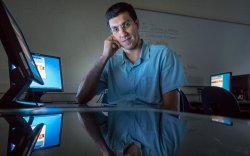Dr. Amir Golnabi, has research featured in prestigious IEEE journal
The research is published in the September issue of Transactions on Biomedical Engineering (TBME).
Posted in: Faculty and Student Research

In this work, 3-D Microwave Tomography Using the Soft Prior Regularization Technique: Evaluation in Anatomically Realistic MRI-Derived Numerical Breast Phantoms, we present methods and results for fusion of magnetic resonance imaging(MRI) breast images with microwave tomography through a soft prior regularization technique. This method incorporates accurate boundary location of different regions of interest from MRI as spatial information into the regularization process of the image reconstruction algorithm.
Methods
Numerical experiments were completed on a set of 3D breast geometries derived from MR breast data with different parenchymal densities, as well as a simulated tumor to evaluate performance over a range of breast shapes, sizes and property distributions.
Results
When the soft prior regularization technique was applied, both permittivity and conductivity relative root mean square error(RRMSE) values decreased by more than 87% across all breast densities, except in two cases where the error decrease was only55% and 78%. In addition, the incorporation of structural priors increased the recovered contrast between tumor and fibroglandular tissue by59% in permittivity and 192% in conductivity.
Conclusion
This study confirmed that the soft prior regularization algorithm is robust in 3D microwave image reconstruction and can function successfully across a range of complex geometries and tissue property distributions.
Significance
This study demonstrates that our microwave tomography is capable of recovering accurate tissue property distributions when spatial information from MRI is incorporated through soft prior regularization. Improvement is substantial and minimizes ambiguity at tissue interfaces. Gains were realized without the aid of priors on the property values, themselves.
